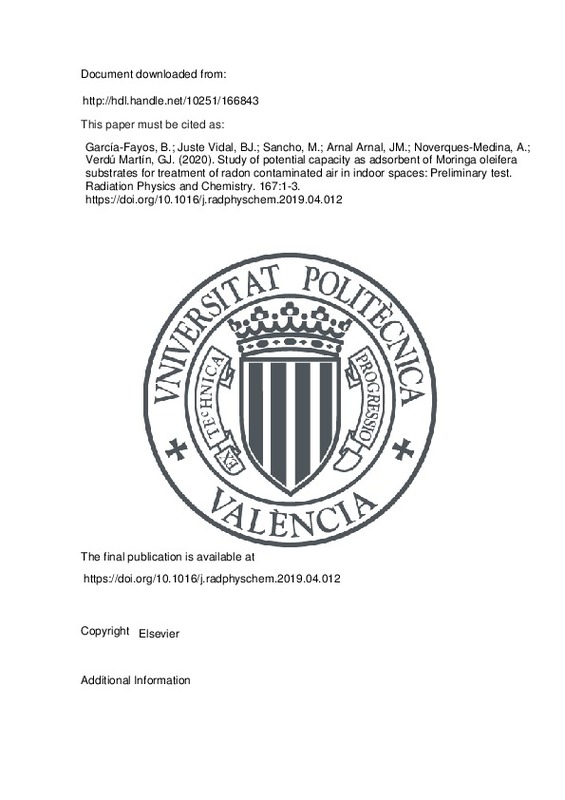JavaScript is disabled for your browser. Some features of this site may not work without it.
Buscar en RiuNet
Listar
Mi cuenta
Estadísticas
Ayuda RiuNet
Admin. UPV
Study of potential capacity as adsorbent of Moringa oleifera substrates for treatment of radon contaminated air in indoor spaces: Preliminary test
Mostrar el registro sencillo del ítem
Ficheros en el ítem
| dc.contributor.author | García-Fayos, Beatriz
|
es_ES |
| dc.contributor.author | Juste Vidal, Belen Jeanine
|
es_ES |
| dc.contributor.author | Sancho, M.
|
es_ES |
| dc.contributor.author | Arnal Arnal, José Miguel
|
es_ES |
| dc.contributor.author | Noverques-Medina, Aina
|
es_ES |
| dc.contributor.author | Verdú Martín, Gumersindo Jesús
|
es_ES |
| dc.date.accessioned | 2021-05-27T03:35:16Z | |
| dc.date.available | 2021-05-27T03:35:16Z | |
| dc.date.issued | 2020-02 | es_ES |
| dc.identifier.issn | 0969-806X | es_ES |
| dc.identifier.uri | http://hdl.handle.net/10251/166843 | |
| dc.description.abstract | [EN] Radon is a radioactive gas known to be a human carcinogenic element that causes lung cancer. The Directive 2013/59/EURATOM establishes action plans for its monitorization and control in water and air specially at workplaces. There are several techniques to reduce the concentration of radon in air mainly based on improving ventilation rates. However, intelligent and energy-efficient buildings are well insulated and have centralized ventilation systems where air is recirculated continuously. This strategy has a negative influence on radon accumulation at indoor spaces. So, ventilation systems should be composed by filters with suitable materials to adsorb radon from indoor air. This work studies the radon adsorption ability of the most used adsorbent (activated carbon) and some not-processed substrates coming from Moringa oleifera, a natural plant with high potential as adsorbent for heavy metals and coagulant in and water treatment. The radon adsorption efficiency of the different solids is analyzed, showing promising results for radionuclide removal from air. | es_ES |
| dc.language | Inglés | es_ES |
| dc.publisher | Elsevier | es_ES |
| dc.relation.ispartof | Radiation Physics and Chemistry | es_ES |
| dc.rights | Reconocimiento - No comercial - Sin obra derivada (by-nc-nd) | es_ES |
| dc.subject | Moringa | es_ES |
| dc.subject | Radon | es_ES |
| dc.subject | Air | es_ES |
| dc.subject | Adsorption | es_ES |
| dc.subject.classification | INGENIERIA NUCLEAR | es_ES |
| dc.subject.classification | INGENIERIA QUIMICA | es_ES |
| dc.title | Study of potential capacity as adsorbent of Moringa oleifera substrates for treatment of radon contaminated air in indoor spaces: Preliminary test | es_ES |
| dc.type | Artículo | es_ES |
| dc.identifier.doi | 10.1016/j.radphyschem.2019.04.012 | es_ES |
| dc.rights.accessRights | Abierto | es_ES |
| dc.contributor.affiliation | Universitat Politècnica de València. Departamento de Ingeniería Química y Nuclear - Departament d'Enginyeria Química i Nuclear | es_ES |
| dc.contributor.affiliation | Universitat Politècnica de València. Instituto de Seguridad Industrial, Radiofísica y Medioambiental - Institut de Seguretat Industrial, Radiofísica i Mediambiental | es_ES |
| dc.description.bibliographicCitation | García-Fayos, B.; Juste Vidal, BJ.; Sancho, M.; Arnal Arnal, JM.; Noverques-Medina, A.; Verdú Martín, GJ. (2020). Study of potential capacity as adsorbent of Moringa oleifera substrates for treatment of radon contaminated air in indoor spaces: Preliminary test. Radiation Physics and Chemistry. 167:1-3. https://doi.org/10.1016/j.radphyschem.2019.04.012 | es_ES |
| dc.description.accrualMethod | S | es_ES |
| dc.relation.publisherversion | https://doi.org/10.1016/j.radphyschem.2019.04.012 | es_ES |
| dc.description.upvformatpinicio | 1 | es_ES |
| dc.description.upvformatpfin | 3 | es_ES |
| dc.type.version | info:eu-repo/semantics/publishedVersion | es_ES |
| dc.description.volume | 167 | es_ES |
| dc.relation.pasarela | S\400861 | es_ES |
| dc.description.references | Garcia-Fayos, B., Arnal, J. M., Piris, J., & Sancho, M. (2016). Valorization of Moringa oleifera seed husk as biosorbent: isotherm and kinetics studies to remove cadmium and copper from aqueous solutions. Desalination and Water Treatment, 57(48-49), 23382-23396. doi:10.1080/19443994.2016.1180473 | es_ES |
| dc.description.references | García-Tobar, J. (2014). Influencia de las condiciones meteorológicas sobre el nivel de radón a corto plazo en un laboratorio subterráneo. Nova Scientia, 6(12), 78. doi:10.21640/ns.v6i12.25 | es_ES |
| dc.description.references | George, A. C. (1984). Passive, Integrated Measurement of Indoor Radon Using Activated Carbon. Health Physics, 46(4), 867-872. doi:10.1097/00004032-198404000-00012 | es_ES |
| dc.description.references | Guyot, G., Sherman, M. H., & Walker, I. S. (2018). Smart ventilation energy and indoor air quality performance in residential buildings: A review. Energy and Buildings, 165, 416-430. doi:10.1016/j.enbuild.2017.12.051 | es_ES |
| dc.description.references | Karunakara, N., Sudeep Kumara, K., Yashodhara, I., Sahoo, B. K., Gaware, J. J., Sapra, B. K., & Mayya, Y. S. (2015). Evaluation of radon adsorption characteristics of a coconut shell-based activated charcoal system for radon and thoron removal applications. Journal of Environmental Radioactivity, 142, 87-95. doi:10.1016/j.jenvrad.2014.12.017 | es_ES |







![[Cerrado]](/themes/UPV/images/candado.png)

